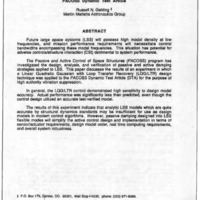-
Title
-
Active Vibration Suppression via LQG/LTR; Analytic and Experimental Results for the PACOSS Dynamic Test Article
-
Report Number
-
WL-TR-91-3078 Volume I, p. CAA-1 thru CAA-22
-
Creator
-
Gehling, Russell N.
-
Corporate Author
-
Martin Marietta Astronautics Group
-
Laboratory
-
Wright Laboratory
-
Date
-
1991
-
Date Issued
-
1991-08
-
Extent
-
22
-
Contract
-
Laboratory Research - No Contract
-
DoD Project
-
2401
-
DoD Task
-
2401-04
-
Identifier
-
ADA241311
-
Format
-
1 online resource
-
Abstract
-
Future large space systems (LSS) will possess high modal density at low frequencies, and mission performance requirements will necessitate control bandwidths encompassing these modal frequencies. This situation has potential for adverse controls/structure interaction (CSI) detrimental to system performance. The Passive and Active Control of Space Structures (PACOSS) program has investigated the design, analysis, and verification of passive and active damping strategies applied to LSS. This paper discusses the results of an experiment in which a Linear Quadratic Gaussian with Loop Transfer Recovery (LQG/LTR) design technique was applied to the PACOSS Dynamic Test Article (OTA) for the purpose of high authority vibration suppression. In general, the LQG/LTR control demonstrated high sensitivity to design model
accuracy. Actual performance was significantly less than predicted, even though the control design utilized an accurate test-verified model. The results of this experiment indicate that analytic LSS models which are quite accurate by structural dynamics standards may be insufficient for use as design models in modern control algorithms. However, passive damping designed into LSS
flexible modes will simplify the active control design and implementation in terms of sensor/actuator requirements, design model order, real time computing requirements, and overall system robustness.
-
Description
-
Future large space systems (LSS) will possess high modal density at low frequencies, and mission performance requirements will necessitate control bandwidths encompassing these modal frequencies. This situation has potential for adverse controls/structure interaction (CSI) detrimental to system performance. The Passive and Active Control of Space Structures (PACOSS) program has investigated the design, analysis, and verification of passive and active damping strategies applied to LSS. This paper discusses the results of an experiment in which a Linear Quadratic Gaussian with Loop Transfer Recovery (LQG/LTR) design technique was applied to the PACOSS Dynamic Test Article (OTA) for the purpose of high authority vibration suppression. In general, the LQG/LTR control demonstrated high sensitivity to design model
accuracy. Actual performance was significantly less than predicted, even though the control design utilized an accurate test-verified model. The results of this experiment indicate that analytic LSS models which are quite accurate by structural dynamics standards may be insufficient for use as design models in modern control algorithms. However, passive damping designed into LSS
flexible modes will simplify the active control design and implementation in terms of sensor/actuator requirements, design model order, real time computing requirements, and overall system robustness.
-
Distribution Classification
-
1
-
Distribution Conflict
-
No
-
DTIC Record Exists
-
No
-
Illinois Tech Related
-
No
-
Photo Quality
-
Complete
-
Report Availability
-
Full text available
-
Type
-
article
 article12
article12